
|
|

© A. R. Dean
Plate 1. A 'song switcher' between Willow Warbler and Chiffchaff songs. West Midlands. April 2009.
Individuals of one species copying or simulating the song of another can be distinctly confusing. There are two basic (but not exclusive) scenarios. In the first, one species switches between sensibly complete song-phrases of its own species and those of a separate species. The two song-types may be contiguous (i.e. delivered as a single phrase) or there may be a pause between the two. In such 'song switching', where complete song-phrases of two species are juxtaposed, the identity of the two species' songs usually remains evident to the human ear. Sometimes, however, the notes from the 'copied' species' song are delivered more rapidly or at a different pitch than is usual in that species, and then its character can be radically altered. The second and more complex scenario involves an intimate mixture of individual notes from the songs of two species in a single song-phrase. In such truly 'mixed song', the result can be especially disconcerting and may resemble the true song of neither species.
Reports are not significantly rare of apparently thoroughbred Willow Warblers Phylloscopus trochilus incorporating song units from Chiffchaff P. collybita into their songs - see Cramp (ed), 1992 (BWP v6, page 657) and this probably applies to a range of species. Cramp (ed), 1992, reported that most individuals with songs incorporating both trochilus and collybita elements were apparently trochilus and noted that the collybita notes 'may be higher and faster than typical, thus acquiring the tonal quality of P. trochilus'. However, Bensch et al. (2001) described a genetically confirmed collybita with song combining trochilus and collybita phrases. This was the first time that the species identity of a so-called 'mixed singer' was genetically confirmed and, more generally, the species and whether it is a thoroughbred are matters of conjecture. For a review of 'mixed singing' in European song-birds see Helb et al. (1985). This paper is also available on-line by subscription; see Abstract.
In the individual described by Bensch et al., although the two species' songs were combined into single song-phrases which were described as 'mixed song', this was more a case of 'song switching' than the intimate admixture of notes of truly 'mixed song.' 'Song switching' may not have a single cause and the individual described by Bensch et al. shows that hybrids may be 'song switchers'. However, it seems likely that consistent 'song switching' may frequently involve simple song copying. One species may imitate the song of the other when a close congener is seen as a potential territorial competitor. Conversely, consistent 'mixed song', involving a much more complex mix of individual notes from two species, seems to me less easy to explain from 'imitation' and may perhaps be a stronger indication of hybrid origin. Occasionally, though, both 'song switching' and 'mixed singing' are encountered from a single individual. In the case of apparently thoroughbred Willow Warblers incorporating Chiffchaff song, Lawn (2018) has suggested that 'character convergence' (in this case involving song convergence) may be involved, as a result of population and habitat changes, and that this could have adaptive benefits.
Truly 'mixed song' as defined above can sound haphazard but on occasion may recall the song of a quite different species. In the case of 'mixed singing' between Willow Warbler and Common Chiffchaff, the result can suggest the song of Siberian Chiffchaff P. (c.) tristis or even Greenish Warbler P. trochiloides. There is in practice a third component sometimes found in anomalous song, in which a single Chiffchaff note is repeated and creates structures not normally found in either species. Such structures can occur in anomalous songs given by individuals with the basic appearance of either species (see examples 4 and 12 below). In this scenario, individual Chiffchaff notes ('chiffs' or 'chaffs') are repeated in clusters. Such clusters delivered rapidly can generate a distinct 'rattle' and seem to occur with some regularity in anomalous songs (see comment on 'template song' at foot of this text). They may at times have a superficial resemblance to the tonal quality of Willow Warbler but, when they occur in Chiffchaff-like individuals, they do not readily suggest an attempt to copy the song of Willow Warbler. In combination with other anomalous notes, such 'rattles' can produce phrases which strongly resemble the song of Iberian Chiffchaff P. ibericus (see Example 4 and 'The Draycote phylloscopus' below). Careful analysis of sonograms can sometimes be necessary to resolve such instances. Iberian Chiffchaff too can produce 'mixed song' (involving ibericus and collybita notes) and is also said to use 'conflict song' which incorporates song-units like collybita, canariensis or trochilus (BWP6, after Thielcke et al. 1978). As the appearance of ibericus is basically intermediate between that of trochilus and nominate collybita, the identity or lineage of 'problematic' individuals which habitually produce an ibericus-like song can be difficult to resolve without nuclear DNA analysis (see Other examples of mixed singers).
Using genetic AFLP analysis, most 'mixed singers' in the overlap zone between Iberian Chiffchaff and nominate Common Chiffchaff in NE Spain and SW France have been shown to be hybrids (Bensch et al 2002). In the overlap zone between Siberian Chiffchaff and Common Chiffchaff of the form abietinus, extending NW from the southern Urals, there is also a significant level of 'mixed song' (Lindholm 2008; Marova et al 2009). Here hybridization between the two forms has also been verified, from a combination of morphological, genetic and bio-acoustic characters (Marova et al 2009, Shipilina et al 2017). Thus, it should not be assumed that an individual using 'mixed song' is copying notes from a congener. That hybridisation is involved needs to be given due consideration.
As noted above, 'mixed singers' and 'song switchers' are not especially uncommon. Between April 2009 and May 2020, during the course of routine birdwatching excursions in the West Midlands region, I encountered eleven examples of 'combination' singers. All involved apparent Willow Warblers incorporating Chiffchaff notes into their repertoire and all at times gave normal Willow Warbler song-phrases (though these were very much a minority in the seventh example). None of these individuals employed the short, churring 'trrt' (or 'tret') note with which Chiffchaffs preface many of their song phrases. In contrast, in June 2023, an intriguing song was heard from an individual which was in appearance a typical Chiffchaff. Each song phrase incorporated four to six standard Chiffchaff notes ('chiff-chaff-chiff-chaff-chiff') but this segment was either preceded of followed without interruption by a rapid 'rattle'. There were also regular 'tret' notes inserted into the song, sometimes in a series. The 'rattle' had only a very rudimentary suggestion of a Willow Warbler fragment and the warbler cannot be confidently classified as a CC-WW 'mixed singer' or 'song switcher'.
Details of these twelve individuals follow.


© A. R. Dean
Plates 2 & 3. A 'song switcher' between Willow Warbler and Chiffchaff songs. West Midlands. April 2009.
The Willow Warbler Phylloscopus trochilus in plates 1, 2 & 3, photographed near Meriden, West Midlands, during April 2009, was switching between the songs of Willow Warbler and Common Chiffchaff Phylloscopus collybita. It re-appeared at the same location in April 2010. In all morphological respects it appears to be a perfectly standard Willow Warbler. Note especially the relatively long wing-point and the pale legs and feet. Several complete phrases of Willow Warbler song were followed by a pause, then several complete phrases of Chiffchaff song, and so on. The song phrases of Willow Warbler were perfect while the song phrases of Chiffchaff were a little hurried compared with a typical Chiffchaff.
Thus, this Willow Warbler was imitating complete phrases of another taxon and was hence a 'song switcher' as opposed to a true 'mixed singer'.

© A. R. Dean
Plate 4. Willow Warbler incorporating Chiffchaff notes into its song. Warks. May 2010.
On May 21st 2010, a Willow Warbler was observed in North Warwickshire (Plate 4) in which each song-phrase began with faltering and rather hurried Chiffchaff-like notes before concluding with normal Willow Warbler song .
During April 2011, a Willow Warbler in the Blythe Valley, West Midlands, was delivering a song incorporating notes from Common Chiffchaff song but with different timbre and more rapid delivery than usual in that species. As a result, these notes had a suggestion of Coal Tit as well as Common Chiffchaff.
As noted above, in such juxtaposed 'song switching', it is quite often the case that the Common Chiffchaff-like notes are delivered at a faster rate than is normal in that species (see Cramp (ed), 2006, BWP v6, page 657).
A recording of the song of the West Midlands individual at its natural speed is here ►.
A recording of the song slowed to 80% of its natural speed is here ►. In this slowed recording the 'identity' of the Common Chiffchaff components of the song is much more evident. The timbre still differs slightly from a 'normal' Common Chiffchaff song but the basic Chiffchaff structure is clear.
A sonogram of the song (at its natural speed) is below:
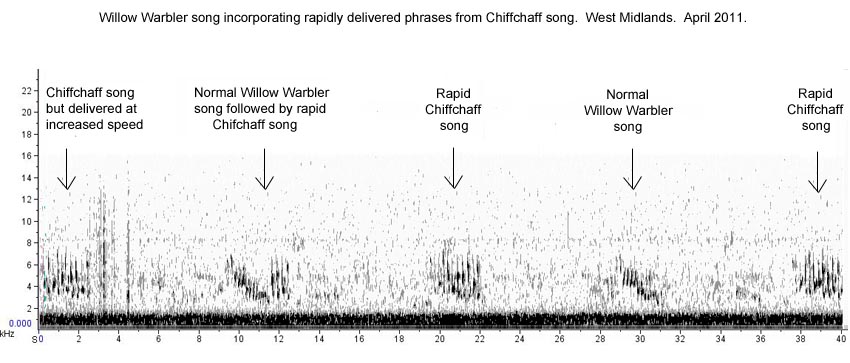
Figure 1.
The Common Chiffchaff components are initially disconcerting but, in fact, they are not particularly abnormal except in the speed of their delivery. Thus, although the song phrases including these Chiffchaff components are initially perplexing, this proves still to be a case of 'songs switching' (or juxtaposing) rather than a truly 'mixed song' as defined above.
Below are sonograms of (a) the Common Chiffchaff-like notes from the Willow Warbler's song and (b) the standard song of Common Chiffchaff.
|
|
|
| (a) | (b) |
Figures 2a & 2b.
There are slight differences in average pitch and timbre but note the basic similarity in the structure of the notes. However, in the Chiffchaff-like song-phrase in the song of the Willow Warbler (a), there are nine notes in two seconds. In the normal Chiffchaff song (b), there are six notes in two seconds.
|
|
|
© A. R. Dean
Plates 5 & 6. Willow Warbler including Common Chiffchaff and Iberian Chiffchaff-like phrases into its song. Warks. April 2011.
The fourth individual was encountered in central Warwickshire, during late-April 2011 (plates 5 & 6). This apparent Willow Warbler also included rapidly-delivered Chiffchaff-like notes juxtaposed with normal Willow Warbler song. However, it also included occasional song-phrases which incorporated several unusual and 'hesitant' introductory notes followed by rapid repetition of a single note, producing a Wren-like rattle though with different pitch and timbre ( c.f. the Wren singing in the background in second recording below). The note-sequence and timbre of this song-phrase strongly resembled the advertising song of Iberian Chiffchaff. This is an example of 'simulation' (though not necessarily intentional) of a component associated with the song of another species, as described in the introduction.
Recordings of the song of the Warwickshire individual are here ► and here ►.
Note how the final song-phrase in the first recording and several in the second recording are very like the advertising song of Iberian Chiffchaff.
A sonogram of the ibericus-like phrase from the Warwickshire bird's song is below. The structure of the first dozen notes corresponds quite closely with sonograms of Iberian Chiffchaff songs recorded in Europe.
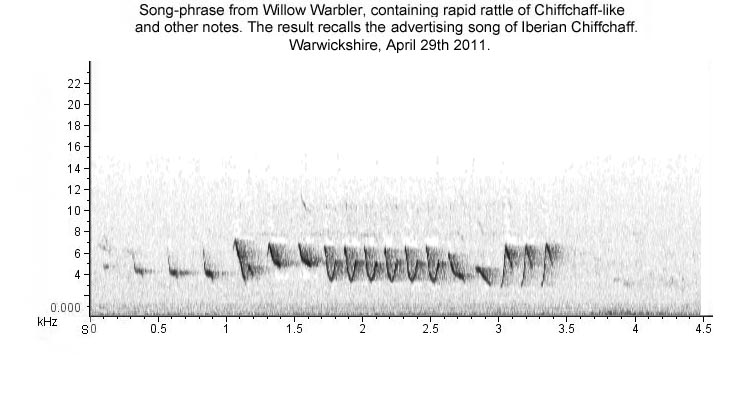
Figure 3.
For comments on Iberian Chiffchaff song and 'mixed singers', see Bensch et al (2002), and for the occurrence of Iberian Chiffchaff-like song in problematic individuals, see Collinson and Melling (2008).
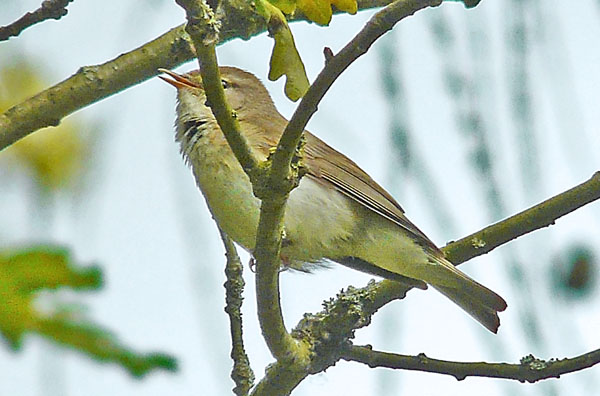
© A. R. Dean
Plate 7. Willow Warbler incorporating Chiffchaff notes into its song. West Midlands. May 2014.
In early May 2014 an apparent Willow Warbler was discovered near Meriden, in the West Midlands, which was a truly 'mixed singer' (plate 7). Individual song-phrases incorporated a variable number of notes from the songs of Willow Warbler and Chiffchaff. Some phrases were thoroughly mixed and others dominated by Chiffchaff-style notes but most were dominated by Willow Warbler notes. The great majority of phrases were 'mixed' at some level and phrases which perfectly matched the song of Willow Warbler were in a minority. Phrases resembling Chiffchaff were quite evident but were slightly less even and slightly more sibilant than in true Chiffchaff song. Sonograms revealed some notes with an abnormal structure for either species, though the timbre and rhythm of notes was clearly attributable to one or the other species.
An extended sequence of song as delivered is here ►. A concatenated series of extracted song-phrases illustrating variable degrees of 'mixing' is here ►. A song-sequence here ► begins with Willow Warbler song; listen carefully and a Chiffchaff begins to sing in the background; the Willow Warbler appears to change its song in response.
Two short extracts of mixed song are here ►, with the corresponding sonograms below. Chiffchaff-style notes predominate in the first phrase while Willow Warbler notes predominate in the second phrase.
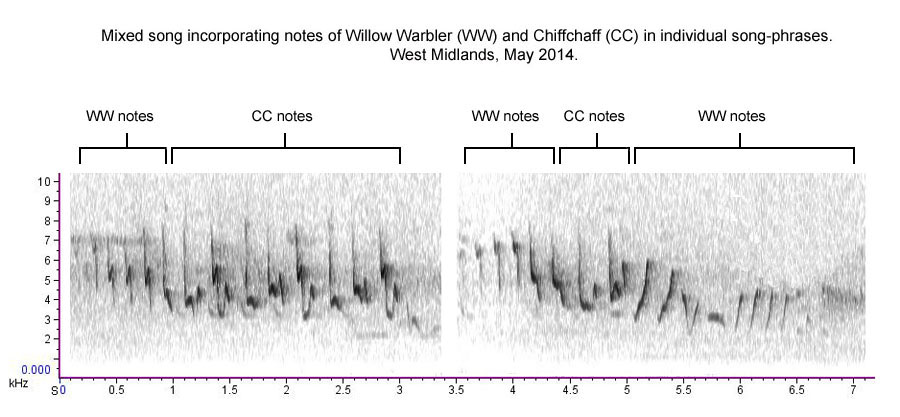
Figure 4.
Finally, to 'compare and contrast', a clean Willow Warbler phrase, a 'mixed' phrase and a Chiffchaff-style phrase have been extracted and juxtaposed here ►, with the corresponding sonogram below.

Figure 5.
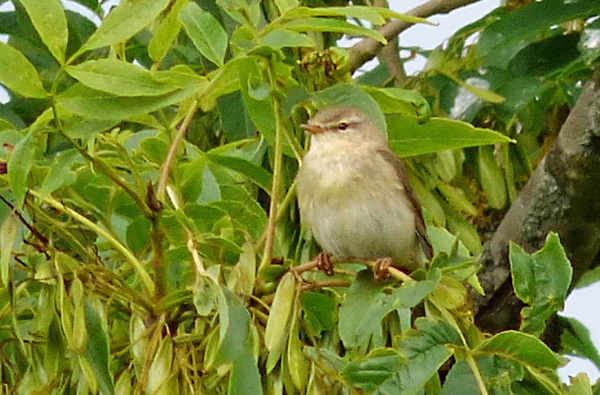
Plate 8. Willow Warbler incorporating Chiffchaff-like notes into its song. Warks. Summer 2015.
In mid-April 2015 another 'mixed singer' was discovered near Packwood in Warwickshire. It remained in the area throughout the summer and consistently used mixed song. This individual delivered perfect Willow Warbler song at times but would frequently introduce mixed phrases and song-switching. At times it would utter phrases composed entirely of Chiffchaff-like notes. Some Chiffchaff notes were reasonable imitations whereas others had imperfect timbre and rhythm for that species. In the concatenated extract here ►, recorded in April 2015, there are onstructs with several consecutive Chiffchaff-like phrases and some efficient imitations. Another example of Chiffchaff-like notes but with evidently different timbre and rhythm is here ►, recorded in June 2015. These phrases have a cadence indicative of more genuinely 'mixed' song.
In June 2015 the song delivered by a 'mixed singer' near Meriden was dominated by phrases which suggested Chiffchaff song. Normal Willow Warbler phrases were very much in a minority. Although the rhythm of the dominant phrases recalls Chiffchaff song, the rapid delivery of the notes and their more fluted (less dry) timbre probably places these phrases into the 'mixed song' category. An example of this individual's song is here ►.
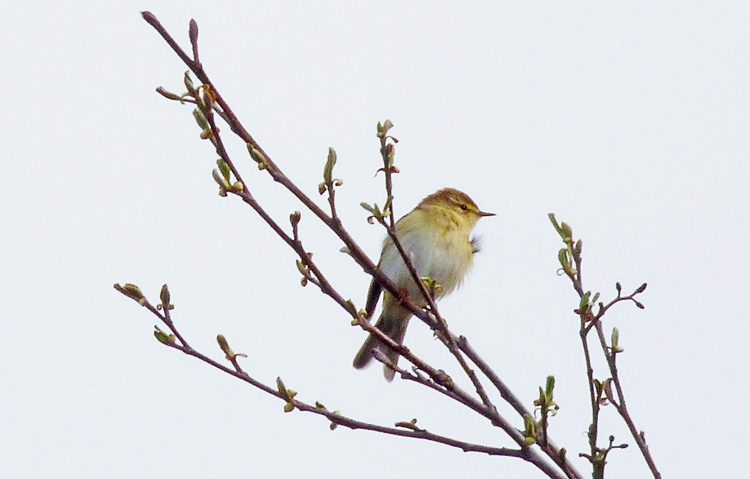
Plate 9. Willow Warbler incorporating Chiffchaff-like notes into its song. Warks. April 2016.
In April 2016 a 'mixed singer' was present in Kingsbury Water Park in Warwickshire. Its song was dominated by Willow Warbler phrases but Chiffchaff phrases were incorporated regularly. Several phrases began with two or three Willow Warbler notes before changing seamlessly into Chiffchaff-like notes. A sequence incorporating several genuinely mixed phrases can be heard here ►. It comprises ten song phrases, of which phrases 1, 5, 8 & 9 are 'mixed'. A sonogram of the eighth phrase is below:

Figure 6.
In May 2016 a 'mixed singer' near Berkswell also delivered predominantly Willow Warbler song but incorporated phrases which began with Willow Warbler notes before changing seamlessly into Chiffchaff-like notes. In the recording ►, there are ten phrases of which numbers 1, 5, 8 and 9 are of this 'mixed' type while the remainder are normal Willow Warbler phrases.
In June 2017, again near Berkswell, a Willow Warbler (on appearance and inclusion of perfect Willow Warbler song at times) gave both WW strophes and occasional strophes comprised of CC notes but delivered with great speed and vehemence of a more even pitch than true Chiffchaff song.
An example of such a CC-like strophe is <here>.
A sonogram of a this phrase sequence' is below:

Figure 7.
Example eleven. Another example primarily a 'song-switcher' but with only very brief or no pauses between sequences of notes of the two species.
In May 2020 a Willow Warbler at Blythe Valley CP gave extended sequences of perfect Willow Warbler song but periodically it would append short series of Chiffchaff notes, virtually seamlessly. Occasionally song sequences would begin with Chiffchaff strophes before reverting to Willow Warbler song. In these cases note sequences of each species were clearly distinguished and constituted 'song switching' rather than true 'mixed singing'. Occasionally, only a few Chiffchaff notes were inserted in the middle of otherwise Willow Warbler sequences and these phrases came closer to 'mixed' singing. Examples of its repertoire are <here>, <here> and <here>. A sonogram of the third example is below:
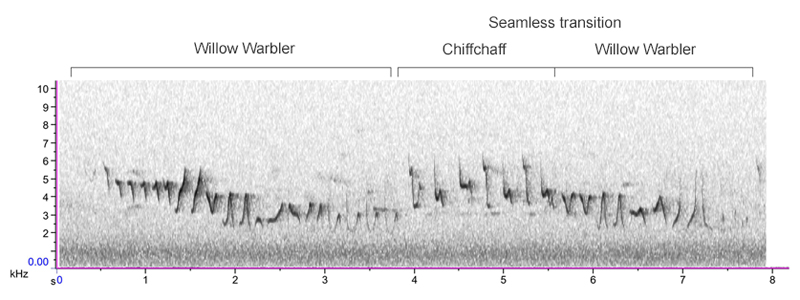
Figure 8.
Example twelve. Combining standard Chiffchaff notes with a rapid 'rattle'.
In June 2023, at Berkswell, West Midlands, the song phrases of an apparently typical Chiffchaff on appearance comprised four to six standard Chiffchaff notes ('chiff-chaff-chiff-chaff-chiff') but with this segment either followed or preceded without interruption by an eight or nine-note 'rattle'. Both types delivered successively can be heard <here>. A sonogram is below:
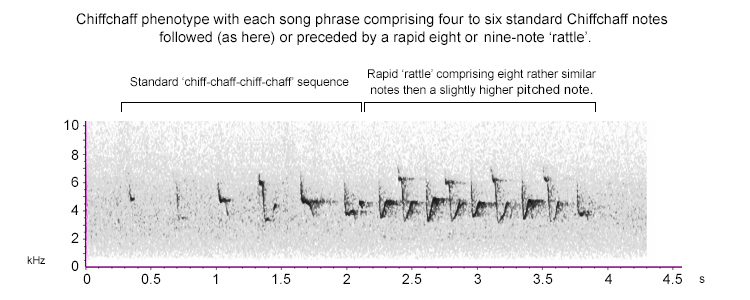
As can be seen in the sonogram, the notes in the 'rattle' include a sequence of eight notes resembling a 'reverse tick' with a sharp frequency minimum. Such notes are not uncommonly found individually in the vocabulary of Chiffchaff but this type of shape does not feature in the opening 'chiff-chaff-chiff-chaff ' segment of the song of this individual. Each of the eight notes in the rattle is of a rather similar shape except that every other note has a small high-frequency 'spur' towards the top of the initial downstroke. The eight notes are delivered in approximately 1.5s with gaps of 0.1s or less between notes. The six standard Chiffchaff notes at the start of the phrase are delivered in approximately 1.9s with gaps of 0.2s or more between notes. If the rattle is slowed to about half-speed, then it emerges as a Chiffchaff-like sequence, with the small spurs creating a 'chiff' and the spurless notes a 'chaff', though the timbre is somewhat awry. Thus, the rattle is a very hurried delivery of notes which can be given by Chiffchaff (but are not employed in the typical Chiffchaff segment of the song given by this individual). Whether this 'rattle' is a rather poor attempt to incorporate a Willow Warbler-like trill into the song or whether it indicates a hybrid origin or whether it is simply an aberrant song from a pure-bred Chiffchaff remains open to speculation.
A 'reverse tick' rattle was also to be found in the song of a Willow Warbler described in 'Example 4' above, where it contributed to a somewhat Iberian Chiffchaff-like song. Thus, such 'rattles' can be found in mixed singers / song-switchers /anomalous singers which are either Chiffchaff-like or Willow Warbler-like in appearance. A comparison between the first strophe of the Berkswell song and a 'Chiffchaff-then-rattle' segment from the repertoire of a warbler at Draycote, Warks, in June 2019, can be heard <here>. The Draycote individual had a varied repertoire but at times could sound very reminiscent of Iberian Chiffchaff, though it never incorporated the diagnostic, rising 'wheep' notes in its song. An analysis by Tim Marlow concluded that it was most likely a hybrid between Willow Warbler and Chiffchaff (British Birds, 2020, 113: 792-796). See the following text for more details of that intriguing individual.
This individual was perhaps the most intriguing of all those documented here and attracted national commentary.
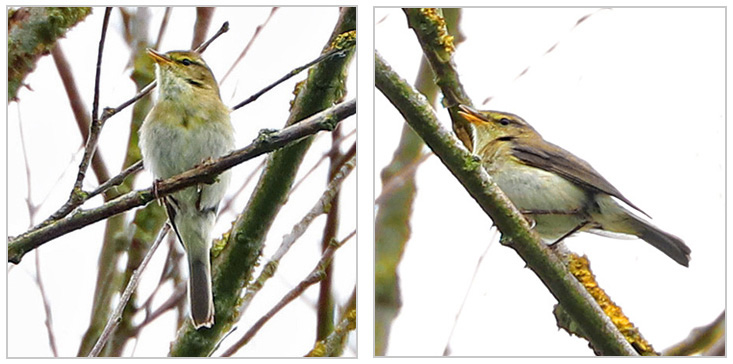
Plate 10. Phylloscopus, with song recalling that of Iberian Chiffchaff. Warks, June 2019.
During the spring of 2019, a Phylloscopus with an intriguing song was present at Draycote Water in Warwickshire. It has been thoroughly documented by Tim Marlow (British Birds, 2020, 113: 792-796). First seen by Richard Knightbridge in late May, its song led initially to suggestions that it was an Iberian Chiffchaff but prolonged observations demonstrated anomalies. The warbler remained on site and in song into mid-July, though singing was most intense during the first two weeks of its stay. The song certainly incorporated ibericus-like notes, including a terminal or subterminal 'rattle' and, indeed, recordings of its song uploaded subsequently to the online song identification program BirdNET result in a diagnosis of ibericus as by far the most-likely contender. However, during its prolonged stay, it was never heard to incorporate into its song the characteristic rising 'wheep' notes of ibericus. One subsequent suggestion was that it was in fact a Willow Warbler using 'mixed song'. However, clear photos taken by Dave Hutton revealed that the wing-structure was unquestionably that of a chiffchaff species, with p6 emarginated and a primary projection of between 50% and 55% (plates 11 & 12). Thus, this individual was not a 'mixed singing' Willow Warbler.
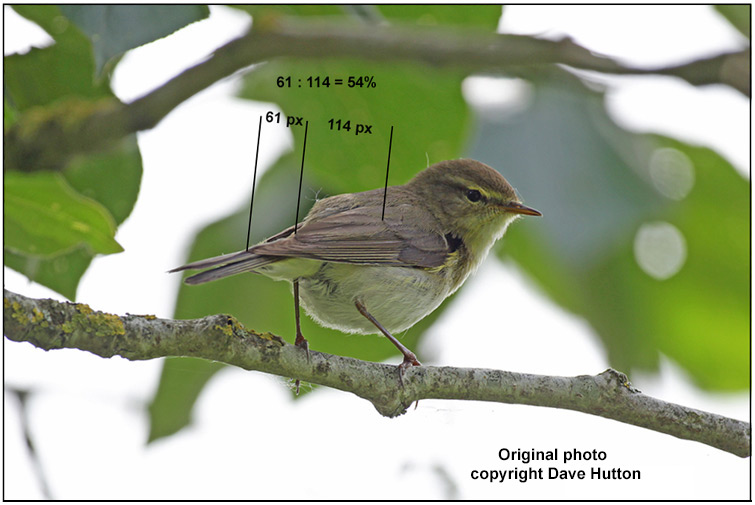
Plate 11. Wing-structure of the Draycote Phylloscupus warbler, The
primary projection is between 50% and 55% of the exposed tertials.
Original photo copyright Dave Hutton.
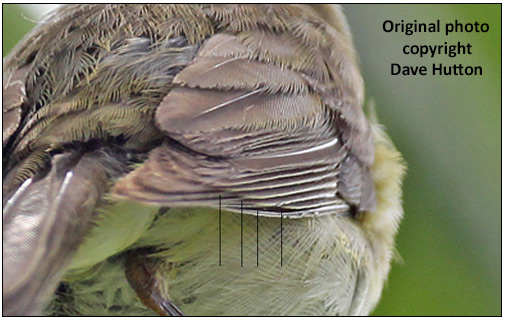
Plate 12. Four primaries are emarginated i.e. including p6.
Original photo copyright Dave Hutton.
The song consistently included a 'rattle' but its 'firmness' varied. An example of ibericus-like song with a good terminal rattle is <here>. A sonogram of this sequence is below:

Figure 9.
Although of a relatively even pitch, all the notes preceding the rattle can be found in collybita repertoire. At times, phrases began with a short series of collybita notes matching the familiar up-down 'chiff-chaff' delivery of typical collybita song. An example is <here>. A sonogram of this sequence is below:

Figure 10.
(Song strophes were frequently separated by short dry notes, sometimes singly, sometimes several in a row but always quite well separated. These notes were quiet and difficult to resolve in sonograms but in structure appeared to resemble the first note in the sonogram depicted in Figure 10. This structure does not appear to equate closely with the 'doubled structure' in sonograms of the dry 'tret' notes frequently uttered by Common Chiffchaffs between strophes of the typical song. See Ivanistskii et al. (2020) for a study and sonograms of 'tret' notes in Common Chiffchaffs and also Mountain Chiffchaffs and how they differ between the various subspecies. Unfortunately, this study did not include ibericus. Thus, the implications of these notes in the Draycote chiffchaff are unclear.)
Two experienced observers reported hearing a trochilus-style song-sequence but complete trochilus-style strophes were clearly exceptional. However, song-sequences with introductory rising notes were not infrequent. An example beginning with three such notes is <here>. A sonogram of this sequence is below. These notes were 'seamlessly' incorporated into the song (no gap). Although they were 'rising' notes, they were much more 'mellow', lower in frequency and of longer duration than the rising 'wheep' notes in ibericus song. Rather, they recalled a mellow version of the call-note of trochilus and a similar note note can be found at times in trochilus song.
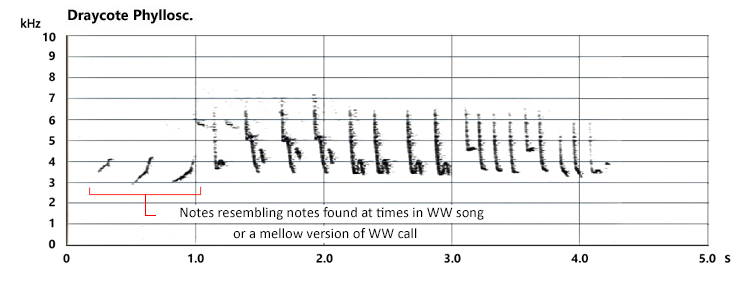
Figure 11.
All these sonograms include an intriguing element with a distinctive structure resembling a number four in 'MV Boli' type-face i.e. 4. There are two in the above sonogram between 3s and 4s.
At normal speed this structure sounds like a single down-slurred note ‘cheeoo’ but, when slowed down in software, it becomes clear that there are two notes closely juxtaposed. This combination is also found in certain recordings of ibericus and was initially thought to be of significance but subsequent examination of many recordings of collybita song has shown that it can be found there too, albeit infrequently.
Thus, the majority of the notes featuring in the Draycote warbler's song can be found in the song of collybita. Collinson and Melling (2008) pointed out that the normal song of trochilus includes homologues of nearly all ibericus notes - though their combination, timbre and spacing do not normally combine into complete ibericus-style phrases. One final consideration is that collybita raised in isolation are reported to have song with a terminal rattle – deemed to indicate an 'ancestral song' or 'song template'. In contrast, BWP6 mentions a case where hybrid trochilus x collybita raised in isolation produced standard trochilus song but wider data on variation in how such hybrids might sing is required. The issues of 'mixed song', 'conflict song' and 'template song' all require clearer documentation.
The identity of this intriguing individual was never unequivocally resolved but, on the basis of appearance and vocalisations, especially lack of the diagnostic rising 'wheep' notes of ibericus, Tim Marlow's documentation (op cit) concluded that a hybrid between Willow Warbler and Chiffchaff was its most likely origin. That 'song switching' involving Willow Warbler phrases was heard by two observers is supportive of this conclusion. Otherwise, options such as ibericus x collybita are hard to exclude with confidence but are arguably less likely in a UK context.
For further examples and discussion of 'combination' songs involving Willow Warbler and Common Chiffchaff, see this item and this item from the Gwent OS website.
Additionally, an apparent Common Chiffchaff with a 'combination' song was recorded during April 2011 in Yorkshire (the late Martin Garner's website).
The website of Annika Forsten and Antero Lindholm contains details and recordings of a 'song switching' Common Chiffchaff in Finland in June 2008. Note, especially, the unusual song-variation in 'recording 4'.
A warbler in Sweden in 2010 was identified as Iberian Chiffchaff but doubts crept in when it began to incorporate into its song Chiffchaff-like notes and Willow Warbler song-phrases (Lars Svensson in lit.).
For more information on 'mixed singing' and 'song switching' see Cramp (ed), 1992, (page 657) and 'The Sound Approach to Birding', 2006, (pages 129-130).
For data on organisation and repertoire in the song of Willow Warbler see Järvi, T., Radesäter, T. and Jakobsson, S. (1980) and Gil, D. and Slater, P.J.B. (2000).
BENSCH, S., NILSSON, L.G.R., NOTHAGEN, P., OLSSON, P. & ÅKESSON, M. 2001. A Chiffchaff Phylloscopus c. collybita with mixed Chiffchaff and Willow Warbler Ph. trochilus song – genetic evidence. Ornis Svecica 11: 108 -110
BENSCH, S., HELBIG, A.J., SALOMON, M., & SEIBOLD, I. 2002. Amplified fragment length polymorphism analysis identifies hybrids between two subspecies of warblers. Molecular Biology 11: 473-481.
COLLINSON, J.M. and MELLING, T. 2008. Identification of vagrant Iberian Chiffchaffs – pointers, pitfalls and problem birds. British Birds 101: 174–188.
CONSTANTINE, M., & THE SOUND APPROACH. 2006. The Sound Approach to Birding: a guide to understanding bird sound. The Sound Approach, Poole.
CRAMP, S. (ed.) 1992. The Birds of the Western Palearctic. Volume 6. OUP, Oxford.
GIL, D. and SLATER, P.J.B. 2000. Song Organisation and Singing Patterns of the Willow Warbler, Phylloscopus trochilus. Behaviour 137: 759-782.
HELB, H.-W., DOWSETT-LEMAIRE, F., BERGMANN, H.-H. and CONRADS, K. 1985. Mixed Singing in European Songbirds — a Review. J. Comp. Ecol. 69: 27–41.
IVANITSKII, V., ILINA,I. & MAROVA I. 2020. The sounds between the strophes: different chiffchaff taxa perform different 'tret' calls in their song. Bioacoustics DOI: 10.1080/09524622.2020.1796788.
JӒRVI, T., RADESӒTER, T. and JAKOBSSON, S. 1980. The Song of the Willow Warbler Phylloscopus trochilus with Special Reference to Singing Behaviour in Agonistic Situations. Ornis Scandinavica 11: 236-242.
LAWN, M. R. 2018. Interspecific territoriality by mixed-singing and song-switching Willow Warblers: a possible case of character convergence. British Birds 111: 334 - 348.
LINDHOLM, A. 2008. Mixed Song of Chiffchaffs in Northern Russia. Alula 14: 108-115.
MARLOW, T. 2020. An apparent Willow Warbler x Chiffchaff hybrid in Warwickshire. British Birds, 2020, 113: 792-796.
MAROVA, I.M., FEDEROV V.V., SHIPILINA, D.A., & ALEKSEEV, V.N. 2009. Genetic and vocal differentiation in hybrid zones of birds: Siberian and European Chiffchaffs (Phylloscopus [collybita] tristis - Ph. c. abietinus) in the Southern Urals. Doklady Biological Sciences 427: 384-386.
SHIPILINA, D., SERBYN, M., IVANITSKII, V., MAROVA, I. & BACKSTRÖM, N. 2017. Patterns of genetic, phenotypic, and acoustic variation across a chiffchaff (Phylloscopus collybita abietinus/tristis) hybrid zone. Ecology and Evolution 2017; 1–12.
Dean, A. R. 2017 et seq. 'Switched' and 'mixed' songs in Willow Warbler Phylloscopus trochilus and Common Chiffchaff P. collybita. https://deanar.org.uk/general/articles/wwmixedsong.htm.
|
|